How is your beaujolais cherie? Moss victorious in his Maserati 250F , chassis ‘2522’ from Peter Collins and Juan Fangio in a shared Lancia Ferrari D50, Jean Behra was third in another 250F ‘2521’…
In fact Fangio finished equal second sharing Peter Collins D50…and equal fourth in ‘his’ D50 sharing it with Eugenio Castellotti. He also won his fourth World Championship that year. His final was won in 1957 in a 250F, giving the marque the success it well deserved, and in the nick of time too, the 250F, long lived and carefully developed as it was had peaked, the mid engined Coopers showing the future path.
Customer Grand Prix Cars for All…
Moss started his post HWM/Connaught grand prix aspirations with the family purchase of a 250F in 1954. He was scooped up by Mercedes Benz as a result of his performances in the car to drive their W196 and SLR Grand Prix and Sports Cars alongside Fangio in 1954/5, returning to the Maserati in 1956.
The fact that Maserati made available the 250F to all comers with ‘the readies’ made a big difference to grids in the mid ’50’ as competitive cars were available for the first time in relatively large numbers. The growth of Non-Championship Grands’ Prix on the Continent was in part due to the availability of the Maser and therefore grids of depth and quality.
Many drivers cut their Grand Prix teeth in the cars, the last 250F graduate grand prix driver retiree was Chris Amon, who departed F1 in 1976!
Mid 1950’s State of The Art…
Amons 500BHP Ford Cosworth powered, winged ,’slicked’, monocoque Ensign N176 was somewhat different to the front engined, tube-framed, skinny tyred, 240 BHP Maserati in which he started his GP career in New Zealand.
The 250F was the ‘state of the art’ in the mid ’50’s. Not as avant garde as its contemporaries the Mercedes W196 and Lancia D50, but state of the art all the same.
Clothed in bodywork worthy of the finest Italian courtiers, to me it is the best looking front engined grand prix car of all. It epitomises everything that was, and is great about Italian design, engineering, styling and construction.
The cars performance matched its looks, it made its debut in the 1954 Argentinian Grand Prix winning the race in Fangio’s hands. The 250F won eight Championship Grands’ Prix in total and countless Non-Championship events in the hands of dozens of drivers through to 1960.
Twenty-six cars were built but of course many more than that exist today…
Design and Build…
The car was designed by Gioacchino Colombo, formerly Ferrari’s Chief Designer, and Valerio Colotti and evolved from Maserati’s A6GCM 2 Litre F1 car.
The 250F featured a multi-tubular space-frame chassis of small diameter chrome molybdenum tubing. De Dion rear suspension was used, the De Dion tube was mounted in front of the transaxle to move weight forward within the wheelbase, lowering the cars ‘polar moment of inertia’ or in simple terms its ability to change direction. The gearbox was transversely mounted in unit with the ZF ‘slippery’ differential, and was initially 4 speed, but later became a 5 speed from 1955.
Conventional double wishbone front suspension was used. Brakes were 13.6 inch finned alloy drums, the fuel tank mounted at the rear contained 200 litres.
The engine was a superb, torquey straight-six, DOHC 2 valve per cylinder, twin plug unit displacing 2494cc. It was fed by 3 twin choke Weber DCO3 carburettors, twin Marelli magnetos providing the spark. The engine initially developed 240BHP, later circa 275BHP @ 8000RPM in 1957. Maserati produced a 2.5 litre V12 for the 250F in 1957, the car was tested extensively and raced once by Behra, 9 years later it won Grands’ Prix in Cooper chassis with a capacity of 3 litres.
The car weighed 650Kg, distributed 48/52% front to rear. It was 4050 mm in length, had a wheelbase of 2280mm, and a width of 1980mm.
Wheels were Borrani aluminium alloy, wire spoked with centre-lock hubs, sizes were 15×4.5 inches circumference/width front, and rear- 16/5.5. Pirelli tyres were used by the works cars.
Its All About Balance…
The 250F may not have been the fastest or most powerful car of its day but it was the best balanced, allowing the driver to fully exploit its potential.
Stirling Moss observed that ‘It steered beautifully and inclined towards stable oversteer which one could exploit by balancing it against power and steering in long, sustained drifts through corners. It rode well on the normal type of relatively smooth surfaced course, although its small coil spring and leaf spring rear end would use up available suspension movement over the bumps at the ‘Ring’.
Historic Context…
Even though the car was not the fastest for most of this period it was still competitive every year, and raced in large numbers, it sort of ‘underachieved’ really. But a lot changed from 1954 to 1957, lets call those the 250F ‘sweet-spot’ years and those circumstances had a lot to do with its results.
In 1954 the Mercedes Benz W196 appeared and re-wrote the record book. The fuel injected, desmodromic valve actuated straight-eight, space frame chassis and ‘tool-room’ quality of its design and construction put everything else into perspective. Mind you, its advantage in 1954 was maybe more to do with Fangio’s driving than the car itself.
Maserati had Fangio for the first few Grands Prix, he won with the 250F in Argentina. When Fangio went off to Benz Maserati did not have a ‘number one’ of sufficient calibre. My contention is that had Fangio driven the 250F in 1954 Maserati would have won the title. Fangio was ‘the depth’ in Mercedes team that year.
Into 1955 the Benz hit its straps, Vittorio Jano’s fabulous Lancia D50 finally appeared in Spain. It was in many ways the equal of the W196, bristling with innovation as well- V8 engine, with the motor a stressed member, very light, pannier tanks to centralise the fuel load equally throughout the race, and of superb build quality.
Moss had finished 1954 as a quasi-works Maserati driver, they needed him in 1955 but he joined Mercedes.
Ascari, Lancia’s star was killed at Monza testing Musso’s Ferrari. Shortly thereafter the sensational ‘shot-gun’ marriage of convenience was consumnated between Ferrari and Lancia when the cash-strapped Lancia, unable to fund its race program, gave its Lancia D50 cars, spares and designer Jano to Ferrari, bereft of a competitive car having stuck with its 4 cylinder F2 derived cars for way too long, and being short of cash to fund a new car in any event.
Maser had Jean Behra as their lead driver in 1955, but they needed somone quicker. In 1955 Maserati was not going to beat the Benzes, even if Moss had stayed with them.
Further change occurred when Mercedes Benz withdrew from racing as a consequence of the 1955 Le Mans disaster when one of their 300SLR sports cars driven by Pierre Levegh collided with Lance Macklin’s Austin Healey. The war was not long ago over, 80 people had been killed, Benz had achieved their short-term aims so it seemed prudent to withdraw.
Moss and Behra led Maserati in 1956, had Moss a car which was more reliable maybe he would have won the title. Mind you, ’tis said he was hard on cars. The Lancia-Ferrari D50 was progressively bastardised by Ferrari who had a strong team of Fangio, Collins, Musso, and Castelotti. Fangio got the best out of the car, and aided by some generous sportsmanship by Peter Collins at Monza, allowing the maestro to use his car, won the title for the fourth time. Maserati were competitive throughout, the title with more luck could have been won by Moss.
In 1957 Fangio won Maserati the title they deserved despite stiff opposition from Moss in the Vanwall, now reliable and with a Colin Chapman designed chassis and Frank Costin body- very fast.
By 1958 the 250F was finally passe as a competitive mount.
As has always been the case teams need to have the best drivers, Maserati’s budget was perhaps the obstacle to achieving that.
My thesis is that they should have won the title in 1954 with the right driver, in 1956 with more luck/reliability and in 1957 finally won it, Fangio doing for Maserati what he had done for Mercedes in 1954/5 and Ferrari in 1956- bringing that little bit of magic, speed, intelligence and mechanical sympathy which separates the gods from the mere mortals.
Finito…
Moss won the opening, Argentinian round of the 1958 season in Rob Walker’s Cooper Climax, the mid-engined revolution had begun. Mike Hawthorn’s Ferrari Dino 246 was the last front engined car to win a World Championship that year, Fangio had retired, and Maserati, drowning with cash-flow difficulties, were placed into ‘Controlled Administration’ by the Italian Government.
It was all over, other than privateers achieving success in Non-Championship events, the car, for a while longer serving the same purpose to privateers as it had back in 1954…
Fangio’s 250F Virtuosity, Modena Circuit, 1957…
Etcetera…

Superb 1956 Bernard Cahier shot of Moss on the Monaco Quayside, late series 250F lines shown to good effect the ‘Piccolo’ of ’57 even prettier
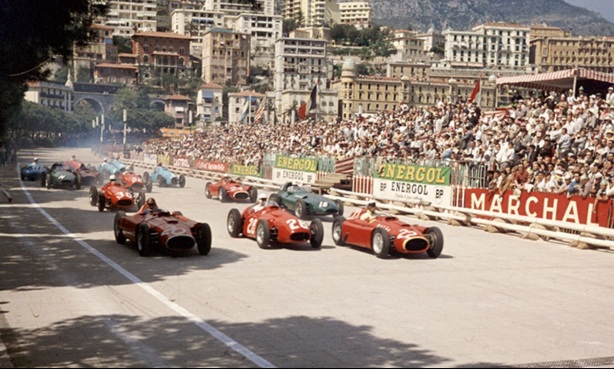
Monaco GP start ’56. Front row L to R : Fangio, Moss, Eugenio Castellotti. Lancia D50, Maser 250F, Lancia D50. # 30 is Jean Behra 250F, # 16 Harry Schell Vanwall VW55, # 24 Luigi Musso D50. # 32 is Cesare Perdisa 250F, # 14 Maurice Trintignant Vanwall, the blue cars are Gordini’s
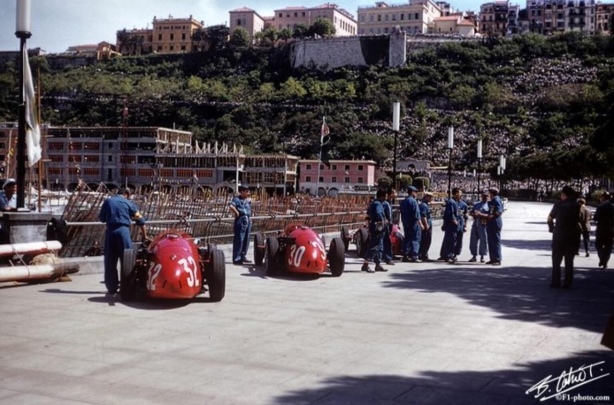
Maserati team prior to the start of the 1956 race: # 32 Cesare Perdisa, seventh, and # 30 Jean Behra, third. Moss’ car is surrounded by mechanics (The Cahier Archive)
Sources and Photos…
The Cahier Archive, David Kimble cutaway drawing, Michael Turner painting, blueprints T Caroli
‘The History of The Grand Prix Car’ Doug Nye, ‘The History of The World Championship’ Alan Henry, H. Donald Capps and Trevor Lister
Tailpiece: 250F’s in build, January 1956…
Technical specifications as per text- what a wonderful and rare photograph by Bernard Cahier of three cars in build taken on his visit to the factory in January 1956- which cars I wonder?
I am guessing, and its no more than that aided by a staggering, so far unpublished work by H. Donald Capps and Trevor Lister titled ‘Identity and the Maserati 250F’ that the cars may be works chassis ‘2516’ fitted with engine ‘2516’- later sold to Australian Reg Hunt, Luigi Piotti’s chassis ‘2519’ fitted with engine ‘2511’ and works car ‘2520’ fitted with engine ‘2520’ later sold to Stan Jones. I say that as all these cars were raced early in 1956, so a January production run makes sense.
In terms of other 1956 build cars, the works ‘2521’ didn’t appear till May, Jean Behra drove it to third in the Monaco race featured above, whilst Moss’s Monaco winner ‘2522’ didn’t run until the April ‘Glover Trophy’ Goodwood meeting. The Godia-Sales ‘2524’ first raced at Spa later in the year too- he didn’t have a good day in the Ardennes with an accident on lap 1 in the wet conditions.
‘Cahier’s three cars are not the 1956 ‘canted engine’ chassis machines ‘2525’ or ‘2526’ which were first raced by Moss and Behra at Monza either, Stirling won on that hot September day in ‘2525’ by the way, so lets stick with the ‘likelies’ as ‘2516’, ‘2519’ and ‘2520’!
Finito…
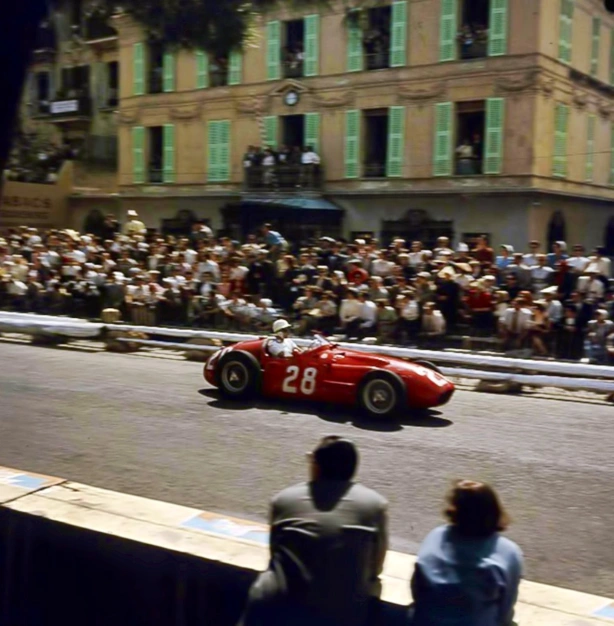
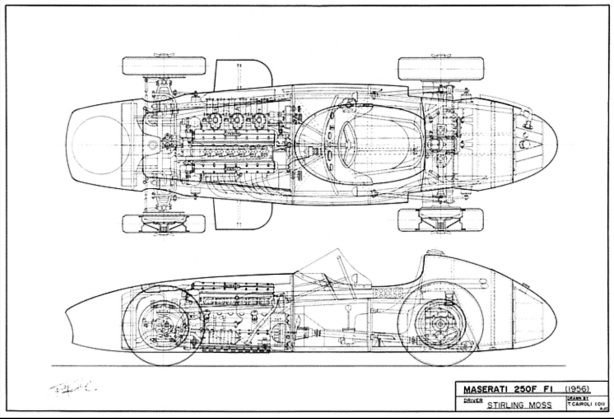


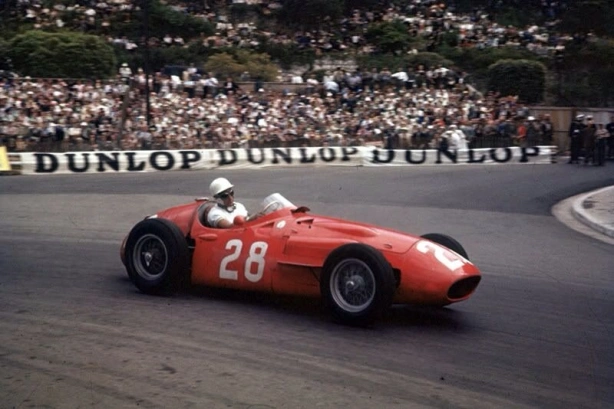
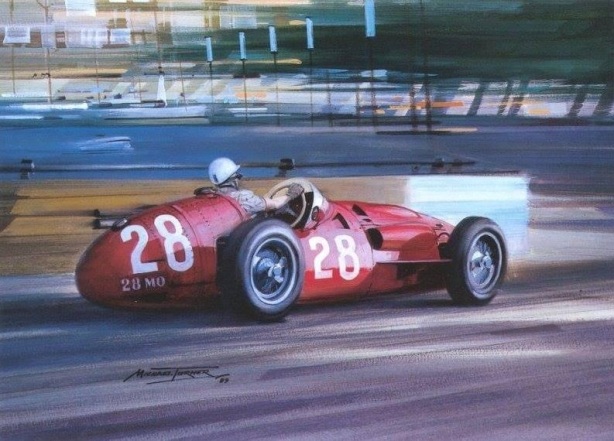



[…] https://primotipo.com/2014/08/21/stirling-moss-monaco-gp-1956-maserati-250f/ […]
The 250F was raced right through to the end of the 2.5 litre formula in 1960, with Bob Drake finishing 13th in the 1960 United States Grand Prix.
From ’54 to ’60, not bad! If I’ve only got a one car choice it’s the 250F! My era is the decades after it but still a tough car to beat on so many levels
[…] Photographer Louis Klemantaski took the shot from his hotel balcony, the long shadows are early morning light. He won the race. Checkout this article on the 250F and this race i wrote a while back; https://primotipo.com/2014/08/21/stirling-moss-monaco-gp-1956-maserati-250f/ […]
[…] Have a read of my 250F article; https://primotipo.com/2014/08/21/stirling-moss-monaco-gp-1956-maserati-250f/ […]
[…] https://primotipo.com/2014/08/21/stirling-moss-monaco-gp-1956-maserati-250f/ […]
[…] https://primotipo.com/2014/08/21/stirling-moss-monaco-gp-1956-maserati-250f/ […]